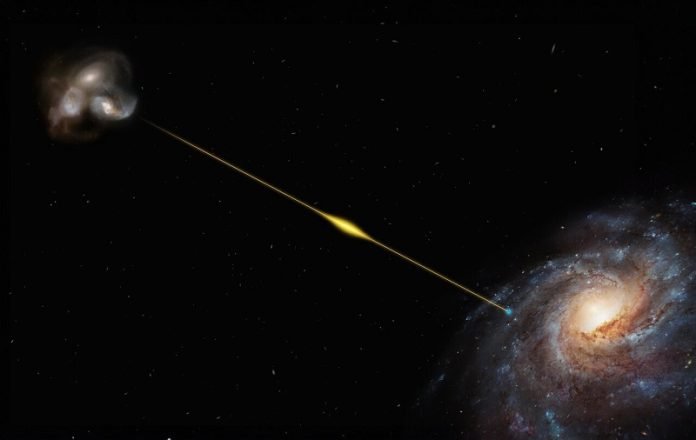
Imagine you’re outside on a clear night, looking up at the stars. Now imagine one of those stars blinking at you super-fast, like the flash of a camera.
That’s kind of what scientists just discovered, but from a star that’s a really, really long way away.
An international group of star-gazers found a quick flash of cosmic radio waves that lasted less than the blink of an eye.
This blink, known as a ‘fast radio burst’ or FRB, is the farthest one they’ve ever seen. The flash came from a galaxy that’s so distant it took the light 8 billion years to get to us!
That’s twice as old as Earth! And in that super short flash, this distant star gave off as much energy as our sun does in 30 whole years.
This discovery was given the fancy name FRB 20220610A. It was first noticed last year by a big telescope in Australia called ASKAP. And this discovery broke the record for the most distant flash they had found by a lot—50% more!
Stuart Ryder, one of the main scientists on this project, explained how they did it. They first used ASKAP to find out where the flash came from.
Then they used another huge telescope in Chile to take a closer look at the galaxy where the flash started.
They found out that this galaxy is older and farther away than any other source of such a flash that we’ve found before. It seems like it might be in a neighborhood of galaxies that are all getting close to each other, kind of like they’re having a party.
But why are these flashes so important? Well, scientists have a big mystery on their hands. When they try to weigh the universe (yes, they actually do that!), the numbers don’t add up.
It’s like when you’re baking a cake and realize you’re missing some ingredients. Here, they’re missing more than half the stuff the universe should be made of.
Ryan Shannon, another leading scientist, said that they think this missing stuff might be hiding in the spaces between galaxies. But it’s really hard to see because it might be super hot and spread out. That’s where these fast radio bursts come in.
These flashes can sense this hidden material in space and tell the scientists how much stuff is out there.
A smart Australian scientist named Jean-Pierre Macquart had a theory in 2020. He said that the farther away a flash is, the more of this hidden stuff it can find.
Some newer flashes seemed to prove him wrong, but this new discovery says he was right. This relationship is now even named after him – the Macquart relation.
Ryan Shannon mentioned that while they still don’t know what causes these powerful flashes, this new discovery proves that these bursts are pretty common out in space. They can help us find the universe’s hidden ingredients and understand how everything is structured.
But here’s the exciting part: we’re just getting started. The telescopes we have today are reaching their limits. But new, even bigger and better ones are being built.
There’s one called the Square Kilometer Array Observatory, which will have two massive radio telescopes in South Africa and Australia. These will be able to spot thousands of these cosmic flashes, even ones further than the one we just found.
Another giant telescope, the Extremely Large Telescope (yes, that’s its name!), is being built in Chile.
It will be able to take a closer look at where these flashes come from, even if they’re super, super far away.
So, next time you’re looking up at the night sky, remember that there’s a lot out there we’re still discovering, and these flashes might just be the key to unlocking some of the universe’s biggest secrets!
Follow us on Twitter for more articles about this topic.
Source: ESO.



